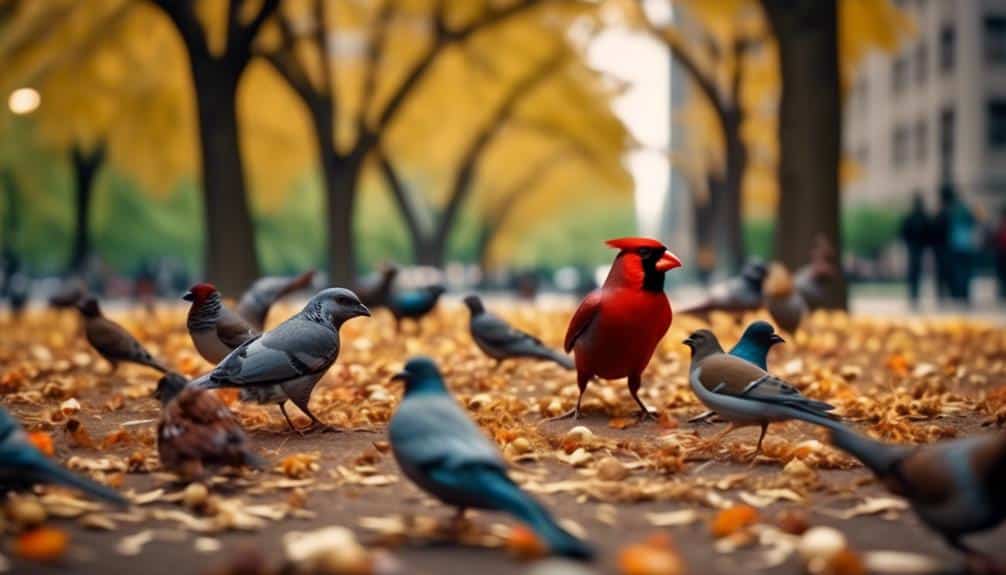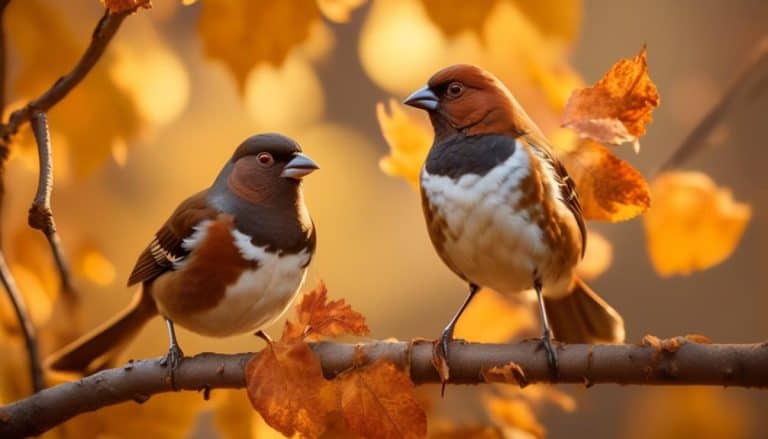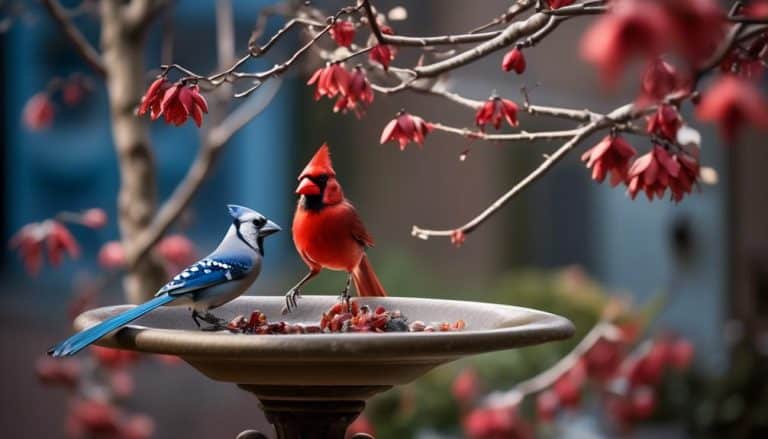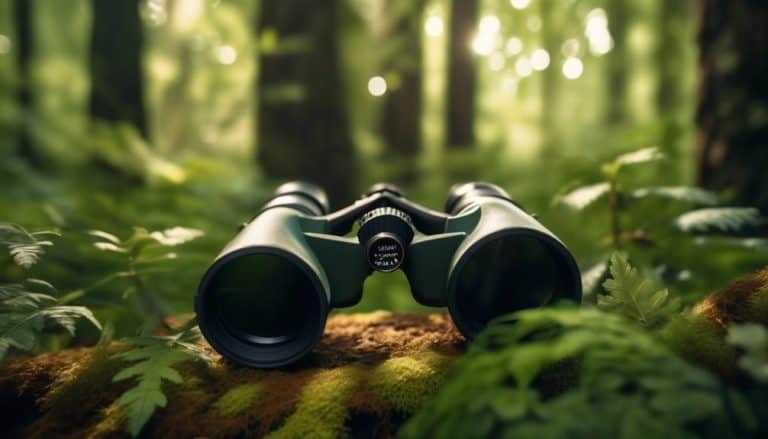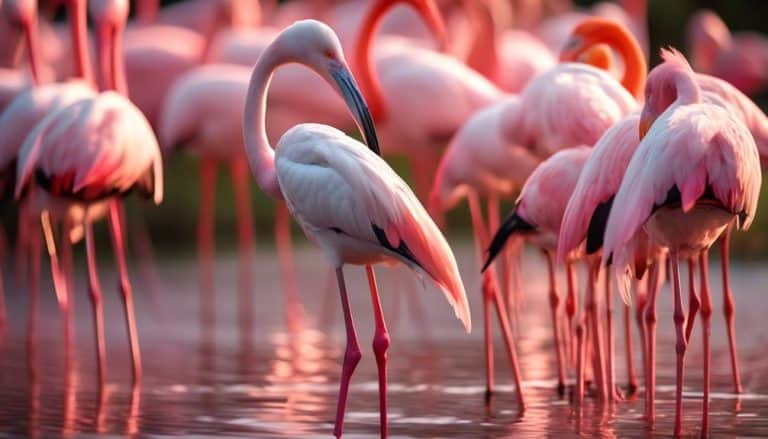Chicago, a bustling metropolis known for its towering skyscrapers and vibrant city life, is also home to a surprising array of common birds. Amidst the concrete jungle, juxtaposed against the urban backdrop, these feathered creatures thrive and add a touch of nature to the daily hustle and bustle.
From migratory birds that grace the city during their journey, to majestic raptors soaring above, and the sweet melodies of songbirds that fill the air, Chicago offers a fascinating glimpse into the avian world.
So, let's take a moment to explore the diverse and captivating birdlife that inhabits the Windy City.
Migratory Birds in Chicago

Every year, thousands of migratory birds make their way to Chicago, transforming the city into a bustling hub of avian activity. These birds follow well-established migration patterns, traveling long distances in search of suitable breeding grounds and food sources. Chicago's strategic location along the shores of Lake Michigan and its diverse habitats make it an attractive stopover for many migratory species.
One of the popular birdwatching hotspots in Chicago is Montrose Point Bird Sanctuary. Situated on the lakefront, this sanctuary provides an ideal resting place for migratory birds. During the spring and fall migration seasons, birdwatchers flock to this location to witness the incredible influx of species such as warblers, sparrows, and shorebirds.
Another notable hotspot is Jackson Park, which offers a mix of woodland, wetland, and open field habitats. This diverse environment attracts a wide variety of migratory birds, including ducks, geese, and herons. Birdwatchers can observe these majestic creatures as they make their way through the park during their seasonal journeys.
Chicago's Lincoln Park is also renowned for its birdwatching opportunities. The park's diverse landscapes, including a nature sanctuary and a bird-friendly pond, attract numerous migratory species. Visitors can witness flocks of birds, such as yellow-rumped warblers and black-crowned night herons, as they rest and refuel before continuing their long journeys.
Waterfowl Species in Chicago
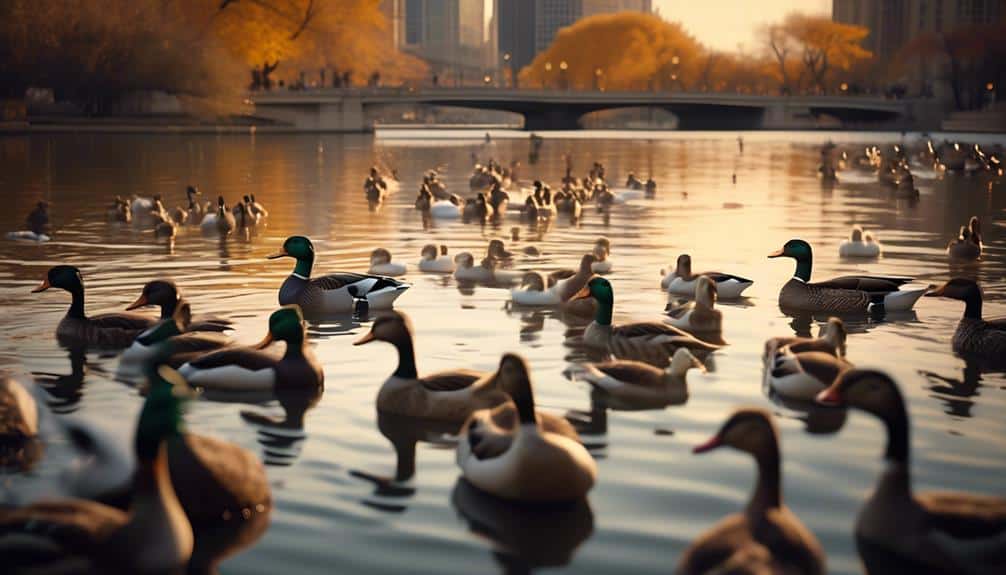
Waterfowl species thrive in the diverse habitats of Chicago, making it a prime location for observing these magnificent birds. With numerous birdwatching spots scattered throughout the city, enthusiasts can easily witness the beauty and grace of waterfowl species in their natural environment. Here are three notable waterfowl species commonly found in Chicago:
- Mallard (Anas platyrhynchos): The mallard is the most common duck species in Chicago. Its vibrant green head, yellow bill, and chestnut breast make it easily recognizable. Mallards can be found in ponds, lakes, and rivers across the city, often seen dabbling in the water or foraging on land.
- Canada Goose (Branta canadensis): Another familiar sight in Chicago, the Canada goose is known for its distinctive black head, white cheek patches, and honking call. These large birds can be found in parks, golf courses, and along the lakeshore, where they congregate in large flocks.
- Wood Duck (Aix sponsa): The wood duck is a stunningly beautiful species with its colorful plumage and unique crest. Often found in wooded wetlands and marshes, these ducks are known for their preference for nesting in tree cavities.
Conservation efforts in Chicago have played a crucial role in protecting waterfowl species and their habitats. Wetland restoration projects, land acquisition, and education initiatives have all contributed to the conservation of these magnificent birds. As a result, visitors and residents alike can continue to enjoy the beauty of waterfowl species in the urban oasis of Chicago.
Raptors of the Windy City
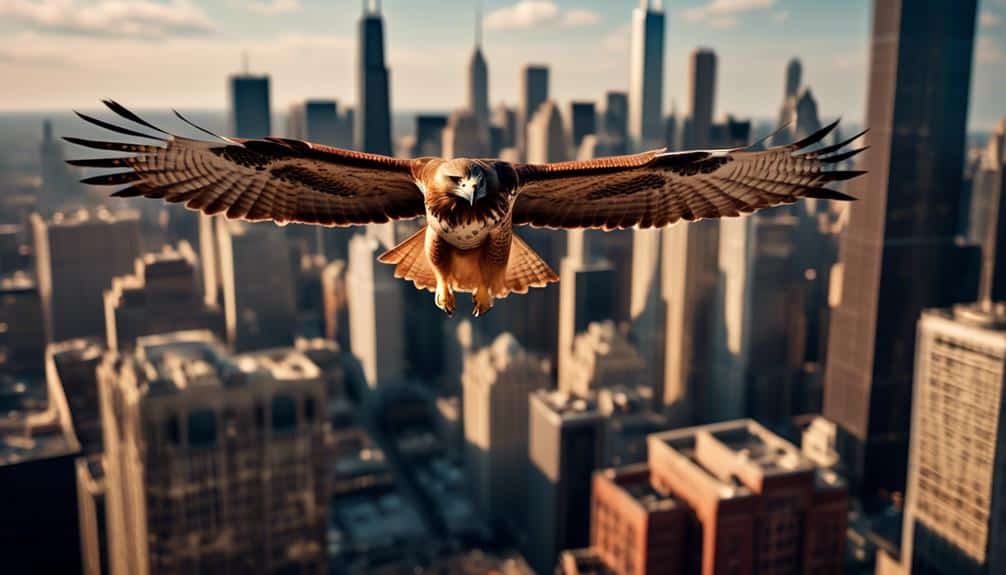
Chicago is home to a diverse array of raptors, making it a captivating destination for bird enthusiasts and researchers alike. Conservation efforts for raptors in Chicago have been effective in ensuring the survival of these magnificent birds. The city has implemented various measures to protect their habitats and promote their well-being. One such effort is the establishment of protected areas and wildlife refuges where raptors can thrive undisturbed. These areas provide essential nesting sites, foraging grounds, and safe migration routes for the raptors. Additionally, educational programs and public awareness campaigns have been instrumental in promoting conservation practices and reducing human-wildlife conflicts.
When it comes to raptor watching in Chicago, there are several locations that offer excellent opportunities to observe these majestic birds in their natural habitat. One of the best spots is Montrose Point Bird Sanctuary, located on the shores of Lake Michigan. This sanctuary attracts a wide variety of raptors, including hawks, falcons, and even the occasional bald eagle.
The Illinois Beach State Park is another popular destination for raptor enthusiasts, with its diverse ecosystems providing ample food sources for these birds. Other noteworthy locations include the Jackson Park Wooded Island and Lincoln Park, both of which offer prime raptor viewing opportunities.
Urban Birds in Chicago
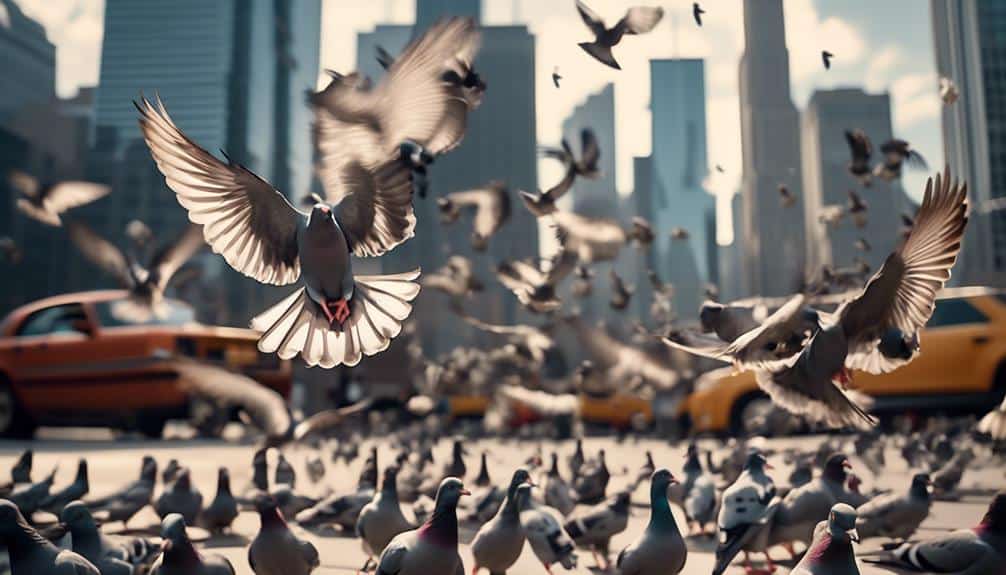
Urban areas in Chicago are teeming with a diverse range of bird species, adapting to the bustling cityscape and finding unique niches within the urban environment. Urban birdwatching has gained popularity among nature enthusiasts, as they explore the city's birding hotspots.
Here are three notable urban bird species commonly found in Chicago:
- House Sparrow (Passer domesticus): This small, social bird is a familiar sight in urban areas. With its brown and gray plumage, it thrives in the city's parks, gardens, and even building eaves. The House Sparrow is known for its cheerful chirping, making it a delightful addition to any urban birdwatching experience.
- Rock Pigeon (Columba livia): Often seen perched on ledges and statues, the Rock Pigeon is a ubiquitous city dweller. Its gray feathers and iridescent neck feathers make it easily recognizable. This species has adapted well to urban life, utilizing buildings as nesting sites and feeding on scraps found in city streets.
- American Robin (Turdus migratorius): Despite its name, the American Robin is a common sight in Chicago's urban areas year-round. With its vibrant orange breast and gray-brown back, it forages for insects and worms on lawns and parks. Its melodious song adds a touch of nature to the urban soundscape.
Exploring these urban bird species in Chicago's birding hotspots provides a unique opportunity to appreciate the resilience and adaptability of wildlife in an urban setting.
Songbirds of the City
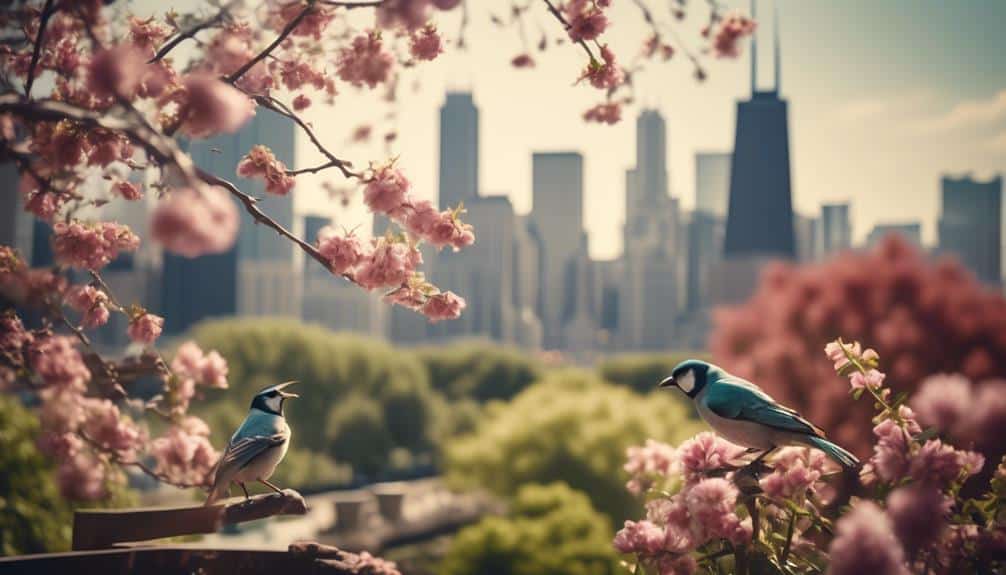
As I continue to explore the diverse avian community thriving amidst Chicago's urban landscape, my attention turns to the captivating world of songbirds within the city. Songbirds, known for their melodious songs, are a common sight in Chicago, adding charm and beauty to the urban environment.
Breeding patterns of songbirds in urban environments are influenced by various factors. One significant factor is the availability of suitable nesting sites. Many songbirds adapt to urban areas by nesting in trees and shrubs found in parks and gardens. They also take advantage of man-made structures, such as birdhouses and nesting platforms, providing them with additional options for breeding.
However, the impact of noise pollution on the songs of city dwelling birds can't be overlooked. Urban areas are often filled with constant noise from traffic, construction, and human activities, which can interfere with the communication and mating calls of songbirds. Studies have shown that excessive noise can lead to changes in songbird behavior, including altered singing patterns and reduced reproductive success.
Despite these challenges, songbirds continue to thrive in Chicago, adapting to the urban environment and enchanting residents with their beautiful songs. Efforts to mitigate noise pollution and provide suitable nesting habitats can help ensure the survival and well-being of these delightful creatures in the city.
Frequently Asked Questions
What Is the Average Lifespan of Migratory Birds in Chicago?
The average lifespan of migratory birds in Chicago varies depending on the species. Factors such as habitat, predation, and disease play a role in their survival. It is important to study and monitor these birds to understand and protect their populations.
Are There Any Endangered Waterfowl Species in Chicago?
Yes, there are endangered waterfowl species in Chicago. Conservation efforts are in place to protect and preserve these species. It is crucial to maintain their habitats and educate the community about the importance of their conservation.
How Many Species of Raptors Can Be Seen in Chicago?
In Chicago, there are several species of raptors that can be spotted. These magnificent birds of prey are a testament to the diversity and beauty of bird migration patterns in the area.
Do Urban Birds in Chicago Face Any Specific Challenges or Threats?
Urban birds in Chicago face numerous challenges and threats due to urbanization. The impact of urbanization on bird populations includes habitat loss, pollution, collisions with buildings, and predation by domestic pets. Urban bird conservation efforts are vital to mitigate these threats.
What Is the Most Common Songbird Species Found in the City?
The most common songbird species found in the city is the American robin. Its cheerful song fills the urban landscape, a testament to the resilience of urban bird populations and the success of bird conservation efforts.
Conclusion
After exploring the diverse avian population of Chicago, it's evident that the city is a haven for a wide range of bird species. From the majestic raptors soaring above the skyscrapers to the melodic songbirds filling the air with their enchanting tunes, Chicago truly offers a remarkable birdwatching experience.
As the seasons change, so do the migratory birds, creating a dynamic and ever-changing spectacle. This urban oasis teeming with feathered inhabitants is a testament to the resilience and adaptability of these remarkable creatures.

